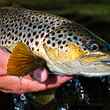Some time ago, when I shared posted a photo of the Rainbow Nymph on my Facebook page somebody asked, “What bug does that match?” The answer, of course, was none.

While it's true that matching the hatch or matching underwater insects is an important factor when we fly fish, there may be days when there may not be any apparent hatches or days when, no matter what imitation you toss, the trout just seem uninterested. Those are the days when you may need to dig into your fly box and tie on an attractor pattern.
Attractor patterns do not represent any particular insect. When Lee Wulff was asked what his fly, the famous Royal Wulff, represented he stated that it did not look like anything in particular but that nonetheless the fish ate it. Such is the case of many other well known attractor patterns, such as the copper john, hare's ear nymph, and humpies.
I like to fish this pattern as dropper to either a dry fly or another nymph. I have listed specific colors of the dubbing and thread for this pattern. However, feel free to use a variety of other colors.
The Recipe
HOOK: TMC 2487 (curved caddis hooks)
THREAD: 8/0 orange
RIBBING: Larva Lace Midge Lace Clear
BEAD: Brass Rainbow Beads
DUBBING: Prism Dubbing and / or Ice Dubbing in colors of: Caddis Green, Electric Blue and UV Red
Prepare your materials.


More Like This
Step 1: Place bead on hook, making sure smaller hole faces the hook eye.

Step 2: Thread the hook evenly toward back of hook.

Step 3: Tie in 1 inch length of Larva Lace.

Step 4: Mix a pinch of each dubbing in a pile. This will be the dubbing for the body. It is best to do this by hand instead of a grinder as you want each specific colors to show through the mix. In other words, a rough mix is perfect.


Step 5: Dub the body with your mixture.

Step 6: Rib the body with the Larva Lace. It's fine to leave a few gaps between ribbing to allow some of the dubbing to peak through. Tie down the Larva Lace behind the bead.

Step 7: Next, dub behind the bead head with the UV Red only.

Step 8: Whip finish the fly behind the bead.

Step 9: The fly is complete.































Comments
Brittany Davenport replied on Permalink
Love the looks of this one! Great job! I will for sure be tying a few of these up for this summer! <3
Aileen Lane replied on Permalink
Thank you, Brittany! Let me know how you do!
Ryan Russell replied on Permalink
Great article! I've used similar things as droppers. For example, what does a "lightning bug" match in Idaho? I'm not sure but they slay as a dropper at times. Experimenting is always the answer. If nothing is working, why not throw one of these on? It's something they might not have seen and like the show Man vs. Food, it may be like Fish vs. Food and they will take a swipe just to try something that looks tasty. :)
Aileen Lane replied on Permalink
Ahhh Yes! The lightning bug is another effective attractor nymph in our waters! Thank you, Ryan!
Michelle Bryant replied on Permalink
This is a great go-to fly to use as a dropper below your hatch matched nymph. I started using this fly this year instead of the zebra midge or small copper john. Although those flies are still successful, this bug seems to attract the bigger bows and bigger browns even. I have presented several "attractor nymphs" but this seems to be most consistent.
Aileen Lane replied on Permalink
I am all for bigger bows and browns!!!
Patti Bantam replied on Permalink
Great article and great advice. I have had the opportunity to cast one or two of Aileen's freshly tied nymphs. They all seem to have the ability to attract that elusive brown trout on even the slowest of days.
Aileen Lane replied on Permalink
Thank you, Patti!
Chad Shmukler replied on Permalink
If only I had anything but ice red dubbing. Very eager to get this on the water. Will have to rectify the problem.
Aileen Lane replied on Permalink
Well, I happen to know someone who can tie these for you. ;)
Brian davenport replied on Permalink
Great fly will definitely be fishing this fly this year. As lee w said cotton candy. Great job on the write up can't wait to see more articles from Aileen
Aileen Lane replied on Permalink
Thank you Brian!
Brian Mowers replied on Permalink
Great advice for a slow day with traditional nymphs Aileen. This is a sure fire attractor. I will have to try this on Oak Creek. Well done!
Brian
Sedona Fly Fishing Adventures
Aileen Lane replied on Permalink
Thanks Brian! Do let me how you do on Oak Creek!
Jeff Davis replied on Permalink
Great fly and tutorial. That fly produces!!! Thanks for sharing.
Aileen Lane replied on Permalink
Thank you Jeff!
Dirk replied on Permalink
Why specifically red dub on the top?
Aileen Lane replied on Permalink
The red is basically a "Hot Spot" for fishing in murky or fast waters when your nymph may go unnoticed. It may work, it may not. Definitely not for spooky fish in clear waters.
Aileen Lane replied on Permalink
But then again, this fly is already flashy that it won't make a difference. lol More of a preference.
Brian Koz replied on Permalink
Always, great looking fly, nicely done Aileen, I shall whip a few and see what they can produce in the Mitten.
Tight Lines!
Koz
Pages